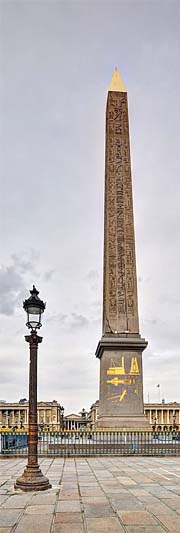This word confusion obelisk vs odalisque is an excellent example of using words to show a character. In this case, the character was a sleazy woman with little education who thought another woman was an obelisk.
Not unless that “obelisk” had seen a gorgon and turned to stone.
I’m sure the character thought an obelisk, really an odalisque, was a pampered woman in a harem — with all the salaciousness that brought to her mind.
Word Confusions . . .
. . . started as my way of dealing with a professional frustration with properly spelled words that were out of context in manuscripts I was editing as well as books I was reviewing. It evolved into a sharing of information with y’all. I’m hoping you’ll share with us words that have been a bête noire for you from either end.
If you found this post on “Obelisk versus Odalisque” interesting, consider subscribing to KD Did It, if you’d like to track this post for future updates.
| Obelisk | Odalisque |
|---|---|

Obélisque de la Concorde, Paris, is Moonik‘s and is under the CC BY-SA 3.0 license, via Wikimedia Commons. |

Odalisque au tambourin by Léon-François Comerre is in the public domain courtesy of ArtNet, via Wikimedia Commons. |
| Part of Grammar: | |
| Noun 1, 2
Plural: obelisks |
Noun
Alternative spelling: odalisk Plural: odalisques, odalisks |
| Noun: A stone pillar, typically having a square or rectangular cross section and a pyramidal top, set up as a monument or landmark 1
[Printing, Lithography, and Bookbinding; obelus] A term in codicology and latterly in typography 2:
|
Noun: [Historical] A female slave or concubine in a harem, especially one in the seraglio of the Sultan of Turkey An artistic representation, often highly eroticized, of such a slave |
| Examples: | |
| Noun: Obelisks were originally constructed by the ancient Egyptians to remember people or events. Cleopatra’s Needles in London, England, and New York City in the USA, and the Luxor Obelisk at the Place de la Concorde in Paris, France, are famous obelisks. The obelisk was erected in his memory in 1812. “There, jutting from the racing waters, stood a dark, jagged stone, not too tall, its rugged jet surface like an unhewn obelisk” (Appignanesi). Modern obelisks have been used in surveying as boundary markers. A obelisk brought her attention to the funeral notice for an old friend. As the obelus version of the obelisk, the division sign was first used by the Swiss mathematician Johann Rahn in his book Teutsche Algebra in 1659. |
Noun: “As to their women, it is a little different: they cultivate beauty from childhood upwards, and may by care and training attain to a certain degree of excellence in that point, just like the oriental odalisques. Yet even this superiority is doubtful” (Brontë). “Odalisques might entertain, clean, and perform a variety of tasks around the harem, the area of a house set aside specifically for the use of women, and they in fact rarely interacted with the men of the household. In rare cases, odalisques became concubines” (McMahon). “A Henri Matisse canvas — Odalisque couche aux magnolias — sold for $80.7 million” (Editors). “Was I deceiving myself in seeing the lineaments of satisfied desire in the roof, a sort of reclining odalisque, however less voluptuous than the figures of the nudes?” (Kuspit). |
| Derivatives: | |
| Adjective: obeliscal, obeliskoid Noun: obelism Verb, transitive: obelizing |
|
| History of the Word: | |
|
Late 17th century, from the French, which is from the Turkish odalik, from oda (chamber) + lik (function). |
C’mon, get it out of your system, bitch, whine, moan . . . which words are your pet peeves? Also, please note that I try to be as accurate as I can, but mistakes happen or I miss something. Email me if you find errors, so I can fix them . . . and we’ll all benefit!
Satisfy your curiosity about other Word Confusions on its homepage or more generally explore the index of self-editing posts. You may also want to explore Book Layout & Formatting Ideas, Formatting Tips, Grammar Explanations, Linguistics, Publishing Tips, the Properly Punctuated, Writing Ideas and Resources, and Working Your Website.
Resources for Obelisk versus Odalisque
Some of these links may be affiliate links, and I will earn a small percentage, if you should buy it. It does not affect the price you pay.
Appignanesi, Lisa. Dreams of Innocence. Dutton, 1995. <https://amzn.to/3V3gjx4>.
Apple Dictionary.com
Brontë, Charlotte. The Professor. chapt 3. Originally published 1857. Wordsworth Editions Ltd, 1998. <https://amzn.to/3LckT7Y>.
The Editors for Art News. “Matisse Portrait Goes for $80.8 M. at Christie’s Rockefeller Sale, Record for Artist at Auction.” Art News. 8 May 2018. Web. 24 Apr 2023. <https://www.artnews.com/art-news/market/matisse-goes-80-8-m-christies-rockefeller-sale-10292/>.
The Free Dictionary: obelisk, odalisque
Kuspit, Donald. “André Cepeda: Benrubi Gallery.” Artforum. 1 Mar 2018. Web. 24 Apr 2023. <https://www.artforum.com/print/reviews/201803/andre-cepeda-74325>.
McMahon, Mary. “What are Odalisques?” Public People.org. 12 Apr 2023. Web. 24 Ap4r 2023. <https://www.publicpeople.org/what-are-odalisques.htm>.
“Obelisk.” Wikipedia. 27 Mar 2023. Web. 24 Apr 2023. <https://en.wikipedia.org/wiki/Obelisk>.
“Obelus.” Wikipedia. 14 Mar 2023. Web. 24 Apr 2023. <https://en.wikipedia.org/wiki/Obelus>.
Pinterest Photo Credits
Odalisque with Tea Set by Pierre-Auguste Renoir is an oil on canvas from the collection of the Barnes Foundation and is in the public domain, via Wikimedia Commons.


